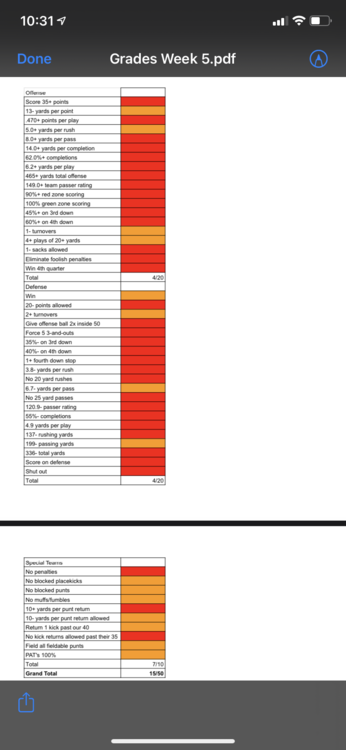Everything posted by hpslugga
-
Critical Race Theory policy in hiring at UT
I’m only going to touch one aspect of what was said above because the rest of it reads like a very poor confession beneath its facade. Amazing. We’re posting on a discussion about people who want to ban the teaching of a subject, which even you concede they know next to nothing about, in public schools (when it’s not even being taught in public schools), and you’re accusing me of wanting to control how other people think. That’s just pitiful.
-
Critical Race Theory policy in hiring at UT
That’s a dodge. Truth isn’t property. It doesn’t belong to me anymore than it belongs to you. Truth has to be demonstrated. That’s why intelligent design is considered a joke. It was falsified in a court of law. Its falseness is a matter of public record; not that I simply “dislike it.” That’s a straw man. And in that society, its truths have to be demonstrated. If they aren’t, they aren’t truths. The way it works is: Positive claims require positive evidence, extraordinary claims require extraordinary evidence, and what is asserted without evidence is dismissed without evidence. THAT is why the “ban CRT!” crowd is a collective failure. They cannot demonstrate the truth of what they say, and it’s very likely because there is no truth to what they say. Imagine that.
-
Critical Race Theory policy in hiring at UT
Except it's not. When I'm right, it's not on me to move towards the wrong position under some misguided notion of "compromise." If I'm a biology teacher and some student wants me to teach Intelligent Design instead of evolution, I'm not going to meet him half way. I have no obligation to do that, and he has no right to ask it of me. He has an obligation to sit his fucking ass down and learn or go to some other school that will teach that debunked garbage. His choice. And what I'm telling you is that it's their problem to deal with and not mine.
-
Critical Race Theory policy in hiring at UT
It doesn't matter what term they're using, even if they're using it as badly as Kent Hovind uses "evolution." What matters is that they are wrong. Their wrongness isn't limited to vocabulary. They're even more wrong when they discuss what lies beneath said vocabulary. It's like a rotten onion that began its rot from the inside: keep peeling that shit and it's only going to look worse.
-
Critical Race Theory policy in hiring at UT
Let's grant that. Hope you can see why people who have a problem with that are dismissed out of hand. Yeah, that's a fantasy. Fantasies do not need to be coddled and one certainly has no right to demand that others do. If you, for example, wanted to go into a biology course and demand that a teacher teaches Stork Theory in lieu of pregnancy because "that's my worldview," he's gonna ask you to take your seat and stop wasting the class' time with your silliness. CRT, in the way you've outlined, is that teacher saying "tough shit." Yeah, reparations are hardly even mentioned in most of the CRT literature I've read (though that's admittedly limited). The issue isn't just history, it's the present. If you're one of those poor fools that seriously believes that racism in America died on August 28th 1963, you're never going to make it in the real world. CRT does not teach that reparations need to be paid to descendants of slaves. If it advocates anything, it's to say to law enforcement "stop targeting minorities." That has short term costs and pain? Either way, what you're talking about is Affirmative Action, which is a distinctly different concept than CRT. Again, if that's the case, tough shit. That's not a legitimate position to take in the real world. It's legitimate in their little cult/ghetto, but it has precious little to do with the real world. It does, but once again, not in the way you think.
-
Critical Race Theory policy in hiring at UT
Yeah that goes two ways, unlike what Dwight Jaynes did. Today, we have a nearly inexhaustible source of information at our fingers that helps us to learn to dispel the idiocy that gets passed around, which is why it doesn't take nearly as strong of a hold. Yeah you're talking about the internet, but the internet has been one of the prime drivers of people falling out of favor with religion, just as an example, at a faster pace than Enlightenment figures could have ever dreamed. To have debunked Dwight Jaynes would have required a judicious study of Mouse Davis' offense and a judicious reading of Ellison's book (and his critique of Davis, which is not widely available) and a careful comparison of the two when you're all finished. Hardly anyone went through that trouble, which is why you never hear any coaches talking about how Mouse Davis =/= Run-and-Shoot. It, like I said, became doctrine and dogma to the broad public. To debunk "Ban CRT!" takes about a 2 minute google search. So yeah, bullshit spreads quickly, but it also gets killed quickly too. Yeah it's become a doctrine and a dogma, but only to those who live in that chickenshit little cult/ghetto that believes in such degenerate nonsense. That doesn't really answer the question. It tangibly touches on social capital, barely, but you also kept referring to worldviews. Again, what "worldview" is being challenged? If you're going to say "the view that whites should be in the majority and therefore in power," ok fine but I doubt you'll go that far because that's probably the most assailable worldview that there is, and you know that. CRT is an examination in how race is a systemic factor in law enforcement/jurisprudence. That's not a "challenge" to anything. When you turn on a flashlight and see a cockroach running around under your refrigerator, you are not "challenging" that cockroach. Similarly, when you observe data on how minorities have been systematically railroaded via the law, that's not a "challenge." Such as? How so? Again, a threat to what?
-
Critical Race Theory policy in hiring at UT
You're describing the distinction between misinformation and disinformation. It's still bad information...as in it's wrong. Dwight Jaynes was being dishonest. He was the spreader of disinformation. But even that took about 12 years to take hold within the broad base of the football world. It was not "virtually overnight." The same is true with CRT. And even with that, it's entirely besides the point because whether it's disinformation or misinformation, it's still fucking wrong and we're not going to move the goalposts to make it magically become right. I'm not going to respond to this any further until you articulate what those "identities, worldviews and social capitals" are.
-
Critical Race Theory policy in hiring at UT
Or worse, that the latter is a legitimate point of view that needs to be respected by those who detest it.
-
Critical Race Theory policy in hiring at UT
Exactly. It is harmful, however. It's harmful to religious extremists who've pined for years to include in public school texts an enormous list of lies asserted as history/science: They want to teach that the Constitution is based on Mosaic Law, which is a lie They want to teach that Africans were brought to the colonies as part of a "guest worker program," which is a lie They seek to minimize the innovations, achievements, and cultural contributions of non-whites, which is a vicious lie They seek to teach Intelligent Design as a scientific theory on par with evolution, which is a spectacular and unforgivable lie. So yeah, they're going to view any challenge to those lies as being "harmful." That's what their dogma teaches. That does not mean we should grant it any loftier consideration than dismissing it absolutely out of hand. We're absolutely right to do that, and they're absolutely wrong to take offense to that.
-
Critical Race Theory policy in hiring at UT
That's actually an old example of the phenomenon in question, but yes, it's a perfect example of how a term/concept became deliberately distorted for reasons that have only to do with the perpetrators of same strawmanning the shit out of anything they don't agree with. It's an example of Godwin's law, only way dumber.
-
Critical Race Theory policy in hiring at UT
They certainly are talking past each other, but not in the way you think. Yes, and the problem lies within the party that perpetually gets them wrong. If you find fault in people who insist on remaining loyal to actual definitions of terms, you're going at things ass backwards. What the "BAN CRT!" crowd is absolutely guilty of is invoking what's known as a strawman fallacy. It's a logical error that merits no serious consideration by serious people. I don't disqualify what they say merely because they're using a grotesquely false definition of the term; I disqualify what they say because their whines and complaints are completely meritless, not to mention dishonest. They assert baseless speculation as though it were a matter of fact, which means they are lying. Then why are they using the term and what is it that they're talking about? Why do they not give a clear and concise summary of their issue in lieu of falsely labeling it as "CRT?" Why do they avoid doing that like a vampire avoids garlic? I'm going to give you an anachronistic analogy to try as best I can to sincerely help you with this: In my bookshelf, there's a book called Run and Shoot Football: Offense of the Future. It was written in 1965 by the architect of the scheme, one Glenn "Tiger" Ellison. Without getting into the specifics of its history, let's just look at how that term is used today. When football fans hear the phrase "Run-and-Shoot," they immediately think of Mouse Davis, Barry Sanders, Warren Moon, Andre Ware, John Jenkins, etc. There couldn't be a more faulty association between those men and that scheme because that's not the 'Shoot. Those men trace all the way back to Mouse Davis, but in its earliest days, Mouse Davis called his offense the Double Slot with Motion. Why is it then called the Run-and-Shoot? Well because some people on this planet are sensationalist, lying assholes and one of those assholes happened to be a reporter for The Oregonian named Dwight Jaynes. When Davis told him he was inspired by that same book that's on my shelf, Jaynes repeatedly insisted on using the book's title to label Davis' offense, over Davis' objections, in every article he was writing about Portland State. Why? Because it, according to him, "sounded sexier than Double Slot with Motion." Over the years, that shit became doctrine and dogma and that's why you have the false association. Who the fuck was Dwight Jaynes to just arbitrarily decide he was going to unilaterally change the lexicon of offensive strategies for his own selfish purposes? Now let's go back to CRT: Who the fuck are these people to just arbitrarily decide they're going to change academic lingo for their own selfish purposes? Seriously, who are these people? I mentioned this either on this thread or a different one a while back, but one of them was a very poorly dressed bum-looking person who spent an entire afternoon at the end of the western median dividing the eastbound and westbound lanes of Mockingbird at the 75 intersection holding up a sign that says "BAN TEACHING CRITICAL RACE THEORY AT HPISD!!!" That stupid asshole has no idea what CRT is, HPISD does not teach it, and yet he and people like him get to insist that the term's definition changes because...what, they want it to? That's not good enough, especially when you consider that if they took a class on CRT at a law school, the overwhelming majority of them would fail rather spectacularly. They pretend to be experts/authorities on the subject, which is a paradigmatic example of Dunning Kruger gone amok. What worldview of theirs is being challenged in public schools? If your identity, worldview and social capital are inextricably linked to racism, racist attitudes, bigotry, bigoted attitudes, etc, you haven't a worldview worthy of consideration. Period. If you want to come here whining and bitching about how people are "talking past each other, not hearing each other," perhaps you should start with the people bitching about CRT when they haven't the foggiest idea what CRT is, or even what they're actually mad about.
-
No, Mike Leach, YOU'RE awesome! [Pirates Last Voyage]
Dude, Baylor went into the 4th with the lead and Tech had to stop them on a 4th down at midfield to preserve a 7-point win.
-
Fascism, Autocracy, Oligarchy Clearinghouse
They do that because it's a stupid person's idea of a smart thing to say. And it's not just cognitive inflexibility; it's cognitive bias that's a huge problem. The people you speak of are extremely ignorant and incompetent on such matters, but they are extremely confident in their own abilities...and they wonder why I accuse them of being afflicted with the Dunning Kruger Effect.
-
Kanye
Lol Donda Academy "Mommy, donda esta mi educacion?" "You go to Kanye's school. Shit if I know!"
-
Conservatives, Big Oil and Gaming Industry are coming for Native American Sovereignty, Again
Very low ceiling with no floor
-
Fair Park- Parking / Transportation / Coupons / Other Shit
Hard stock here
-
Cole Beasley Sent Home From Bills Facility On Tuesday
I heard this in Stephen Baldwin’s voice. “If evolution is real, why didn’t the apes all die out?”
-
Texas/ou 11am on ABC
Don't forget Jerrod Heard
-
Texas/ou 11am on ABC
I'm guessing the winner of TX-OU gets the 6:30 next week?
-
Grading the Team’s Performance Week 5
A few remarks: 1. Omg 2. Wtf 3. I think that’s the lowest grade they’ve earned in a win since I started doing this in 2005 4. There were at least two punts TCU had where the ball took a hard bounce their way, but I do not say that’s a fail on the fieldable punts metric because I contend those balls were not fieldable. The first one wasn’t even close and I still say the second one failed to meet that description. 5. In all seriousness I’m glad this one happened the week that it did. The team hasn’t won a lot of shit grade games like these in recent years, let alone a road game against a team (chickenshit though they are) that’s had their number for the past near decade. This was a game that we found out the offense could still churn 30 points out of their asses even with a sub-par game by Casey (all QB’s are bound to have these) and that Bijan could handle a 35-carry game that is seldom seen in this age. Hopefully Sark is treating this as a loss.
-
Justin Tucker
"Carney also pointed out that Tucker takes a wide approach from his start point - a technique that was popular in the 1970s and 1980s but fell out of favor in the 1990s as kickers began to come at the ball from a narrower angle to increase accuracy. “Being wide allows you to get a lot of turn on the ball, you get a lot of hip and turn and rotation, which translates into power" Essentially it's a fusing of this principle along with what he also says about core strength. Some of the longest kickers in league history just flat out didn't have that. Did any coach ever look at Sebastian Janikowski, Nick Lowery or Morten Andersen and think "man if only my kickers had their core strength?" No fucking way. They looked at those guys and marveled only at their raw leg power. Justin has the leg power of a Janikowski but he also has the core control of Mike Vanderjagt, which is what makes him such a weapon...especially since he isn't the headcase those two guys were.
-
Lincoln Riley throws covid parties at nursing homes.
- Lincoln Riley throws covid parties at nursing homes.
Lincoln Riley supported the Contras- Texas/ou 11am on ABC
Doesn’t mean I want her sitting next to me, does it?- Texas/ou 11am on ABC
If you ordered tix from TicketCity, when would you normally expect to actually receive them? - Lincoln Riley throws covid parties at nursing homes.
Football ...
Basketball ...
Baseball ...
Other Sports ...
Futbol ...
🤫995🤫 ...
Gambling ...
Movies & TV ...
Music ...
Hobbies ...
Lulz ...
Food & Travel
...
Daily Texan ...
Business & Markets ...
Cloak Room ...
Help ...
For Sale ...
Board Discussion ...
Advertise...
Tailgate Donations
Back to top





